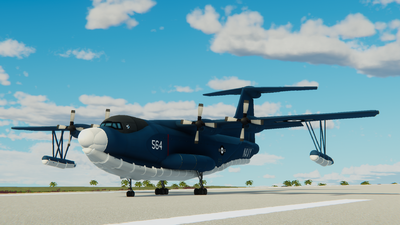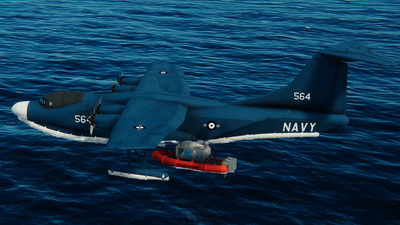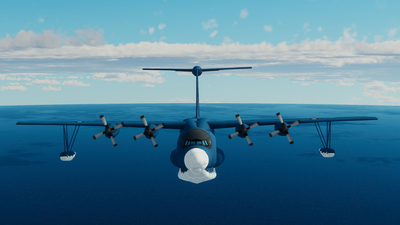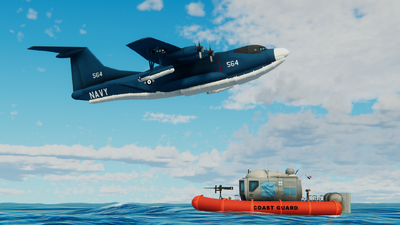CJ-8 Highline: Difference between revisions
(Created page with " {{Craft|name=|image=ZokeScreenshot10952.png|origin=Zokesia|type=Air-sea rescue amphibian|designer=Cyten-Ward Industries|built=7|cost=98,652|serv_start=2183|operators=The Confederacy|prod_start=2183|imagedesc=CJ-8 on maritime patrol}} The '''CJ-8 Highline''' is a Zokesian short takeoff and landing amphibious aircraft that employs boundary layer control technology for enhanced STOL and stall suppression performance. Manufactured by Cyten-War...") |
m (→Design) |
||
| (2 intermediate revisions by the same user not shown) | |||
| Line 1: | Line 1: | ||
| − | {{Craft|name=|image=ZokeScreenshot10952.png|origin=[[Zokesia]]|type=Air-sea rescue amphibian|designer=[[Cyten-Ward Industries]]|built= |
+ | {{Craft|name=|image=ZokeScreenshot10952.png|origin=[[Zokesia]]|type=Air-sea rescue amphibian|designer=[[Cyten-Ward Industries]]|built=12|cost=98,652|serv_start=2183|operators=[[Arcovii-Zokesia|The Confederacy]]|prod_start=2183|imagedesc=CJ-8 on maritime patrol}} |
The '''CJ-8 Highline''' is a Zokesian short takeoff and landing amphibious aircraft that employs boundary layer control technology for enhanced STOL and stall suppression performance. Manufactured by [[Cyten-Ward Industries]], it was developed to perform search and rescue, long-range maritime patrol, and convoy escort duties. |
The '''CJ-8 Highline''' is a Zokesian short takeoff and landing amphibious aircraft that employs boundary layer control technology for enhanced STOL and stall suppression performance. Manufactured by [[Cyten-Ward Industries]], it was developed to perform search and rescue, long-range maritime patrol, and convoy escort duties. |
||
==Design== |
==Design== |
||
| − | On 18 December 2183, flight testing of the type, which was subsequently designated as the CJ-8, commenced. During early 2187, Cyten-Ward formally launched commercial production of the amphibian. Production is handled by several of Zokesia's aviation companies. [[Logi Motor Company]] manufactures the outer wing sections and the rear part of the engine nacelles, while [[Bayl Ironworks]] |
+ | On 18 December 2183, flight testing of the type, which was subsequently designated as the CJ-8, commenced. During early 2187, Cyten-Ward formally launched commercial production of the amphibian. Production is handled by several of Zokesia's aviation companies. [[Logi Motor Company]] manufactures the outer wing sections and the rear part of the engine nacelles, while [[Bayl Ironworks]] builds the watertight landing gear housings, and Cyten-Ward Industries produces the cockpit. Final assembly is performed by Cyten-Ward around the CJ-8's hull. The production line only has the capacity to produce two aircraft at a time. During 2189, the first production CJ-8, which was outfitted for the search and rescue mission, was delivered to the the Confederate Navy. |
| + | |||
| + | |||
In 2190, Cyten-Ward unveiled specifications for a civil fire-fighting variant of its CJ-8 amphibian. It began marketing the new variant to potential overseas customers that same year. The fire-fighting model replaces one fuel tank with a 15 tonne water tank, reducing its maximum range to 2,300 km (1,245 nm) compared with the SAR's 4,700 km range. The tank is durable enough for salt water, foam and fire retardant. Other features include a pair of water scoops for collecting water, automatic foam mixing equipment and a computer-controlled water drop system.<gallery mode="packed" widths="500" heights="150"> |
In 2190, Cyten-Ward unveiled specifications for a civil fire-fighting variant of its CJ-8 amphibian. It began marketing the new variant to potential overseas customers that same year. The fire-fighting model replaces one fuel tank with a 15 tonne water tank, reducing its maximum range to 2,300 km (1,245 nm) compared with the SAR's 4,700 km range. The tank is durable enough for salt water, foam and fire retardant. Other features include a pair of water scoops for collecting water, automatic foam mixing equipment and a computer-controlled water drop system.<gallery mode="packed" widths="500" heights="150"> |
||
| Line 12: | Line 14: | ||
File:ZokeScreenshot10986.png |
File:ZokeScreenshot10986.png |
||
</gallery> |
</gallery> |
||
| + | [[Category:Aircraft]] |
||
Latest revision as of 19:01, 28 October 2024
|
CJ-8 Highline
|
|||||
|---|---|---|---|---|---|
| Air-sea rescue amphibian | |||||
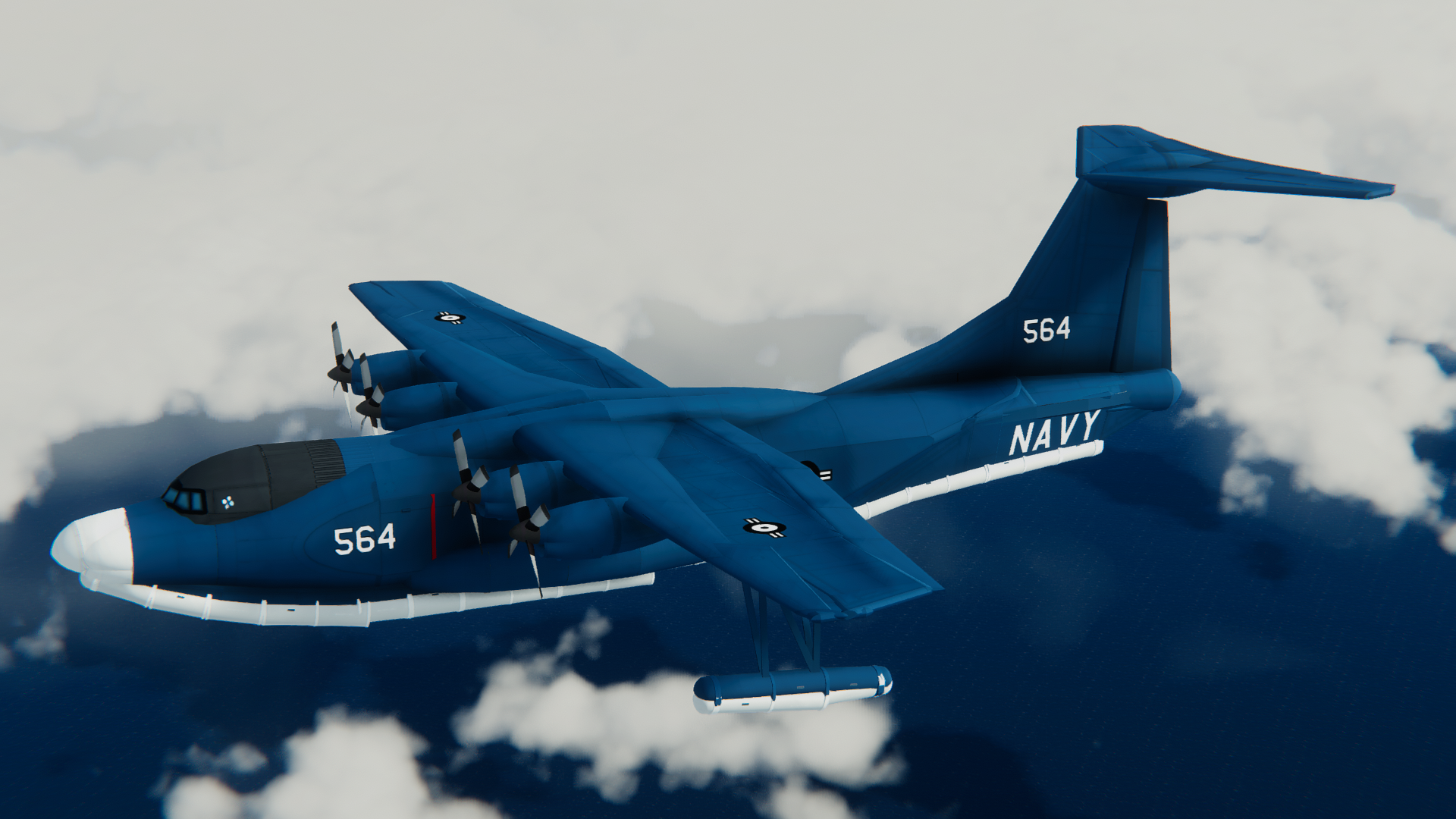 |
|||||
| CJ-8 on maritime patrol | |||||
| National Origin | Zokesia | ||||
| Production History | |||||
| Designer | Cyten-Ward Industries | ||||
| Unit Cost | 98,652(√) | ||||
| Number Built | 12 | ||||
| Service History | |||||
| Used By | The Confederacy | ||||
The CJ-8 Highline is a Zokesian short takeoff and landing amphibious aircraft that employs boundary layer control technology for enhanced STOL and stall suppression performance. Manufactured by Cyten-Ward Industries, it was developed to perform search and rescue, long-range maritime patrol, and convoy escort duties.
Design
On 18 December 2183, flight testing of the type, which was subsequently designated as the CJ-8, commenced. During early 2187, Cyten-Ward formally launched commercial production of the amphibian. Production is handled by several of Zokesia's aviation companies. Logi Motor Company manufactures the outer wing sections and the rear part of the engine nacelles, while Bayl Ironworks builds the watertight landing gear housings, and Cyten-Ward Industries produces the cockpit. Final assembly is performed by Cyten-Ward around the CJ-8's hull. The production line only has the capacity to produce two aircraft at a time. During 2189, the first production CJ-8, which was outfitted for the search and rescue mission, was delivered to the the Confederate Navy.
In 2190, Cyten-Ward unveiled specifications for a civil fire-fighting variant of its CJ-8 amphibian. It began marketing the new variant to potential overseas customers that same year. The fire-fighting model replaces one fuel tank with a 15 tonne water tank, reducing its maximum range to 2,300 km (1,245 nm) compared with the SAR's 4,700 km range. The tank is durable enough for salt water, foam and fire retardant. Other features include a pair of water scoops for collecting water, automatic foam mixing equipment and a computer-controlled water drop system.
